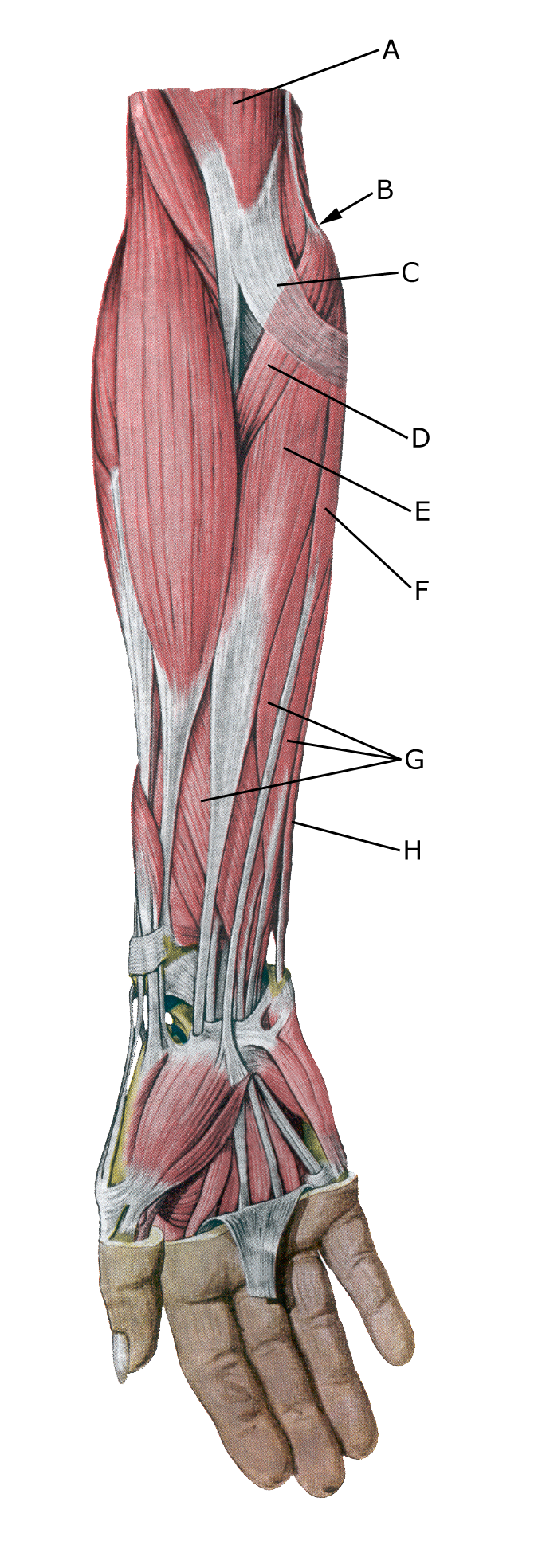Anatomy
The elbow joint is formed by the humerus and ulna. The other forearm bone (radius) forms a joint with the ulna (species radioulnaris proximalis). Around the elbow joint is a joint capsule and several reinforcing ligaments.
 Two major muscle groups of the forearm attach to the elbow, one on the outside (lateral epicondyle) and one on the inside (medial epicondyle), where in adolescents there is a growth zone (apophysis) that increases the risk of overuse symptoms. The forearm muscles that attach to the inside of the elbow flex (flex) and rotate (pronate) the hand. A ligament that stabilises the elbow (ulnar collateral ligament) attaches in the same place.
Two major muscle groups of the forearm attach to the elbow, one on the outside (lateral epicondyle) and one on the inside (medial epicondyle), where in adolescents there is a growth zone (apophysis) that increases the risk of overuse symptoms. The forearm muscles that attach to the inside of the elbow flex (flex) and rotate (pronate) the hand. A ligament that stabilises the elbow (ulnar collateral ligament) attaches in the same place.
Forearm flexor muscles
A. M. biceps brachii
B. Epikondylus mediale
C. Aponeurosis m. bicipitis brachii
D. M. pronator teres
E. M. flexor carpi radialis
F. M. palmaris longus
G. M. flexor digitorum superficialis
M. flexor carpi ulnaris
Cause
Repeated repetitive strain of the forearm muscle (e.g. overhand throwing, racket sports, baseball) in 6-16 year olds causes an overload-related ‘inflammation’ at the forearm muscle attachment on the growth zone (apophysis) inside the elbow (medial epicondyle).
It is the most common injury in young baseball players, which is why the injury is called ‘Little League Elbow’ (Hodge C, Schroeder JD. 2023). In some cases, the apophysis can be torn off, which in rare cases can cause nerve damage.
Training load should be reduced during periods of rapid growth (measure the height of young athletes every 3 months). Training should generally be varied and avoid repetitive movements. Alternate between different exercises over time to reduce strain. Quality of training is more important than quantity.
Symptoms
Slow-onset tenderness inside the elbow (medial epicondyle) during and after sports activity. With prolonged discomfort, the bony attachment on the elbow will become more prominent. Once the growth zone on the elbow closes around the age of 17, symptoms usually subside.
Acute treatment
Examination
The diagnosis is usually made on general clinical examination, where there is localised pressure tenderness on the inside of the elbow (medial epicondyle) with worsening when the hand is flexed against resistance and when the inner ligaments are tested for stability (valgus stress).
In case of doubt, it may be necessary to supplement with an ultrasound scan (or possibly an X-ray), which in severe cases can show swelling and increased opening of the growth zone (apophysitis).
Treatment
Starting treatment as soon as possible and not rushing rehabilitation is crucial for prognosis. Treatment includes relief from pain-inducing activity (throwing, overhand hitting) often for at least 4-6 weeks, while many other training exercises can be performed without discomfort. If treatment is started quickly, the injury can sometimes heal in a matter of weeks.
If the pain has been present for several months, the relief period can be significantly longer. Once the pain has subsided, sporting activity can be gently resumed. More than 20% will experience a relapse ( Jensen JJ. et al., 2024 ), after which reloading should begin as soon as possible. Only in very rare cases, surgery may be necessary, such as if the apophysis is torn.
It is important that the athlete, parents and coach are informed, understand and respect the need for load management during the rehabilitation period in order to avoid long-term injuries that can last six months to a year (Longo UG. et al., 2016 ).
